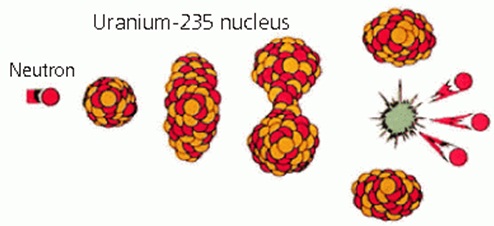Assignment:
QUESTIONS
1. Particles going through a magnetic field will
a. be deflected if they are charged
b. not be affected if they are electrically neutral
c. not be affected whether they are charged or uncharged
2. In the following fission reaction, the atomic number and mass number of nucleus I(Indium) are:
n + 23592U AZI + 9939Y + 2n
a. 51, 137
b. 53, 135
c. 55, 137
d. 92, 236
3. For the same energy, the most penetrating type of radiations in human tissue are ________.
a. alpha particles
b. beta particles
c. gamma rays
4. At 11 a.m. on Wednesday a radioactive sample contained 2 million nuclei. At 11 a.m. on Saturday 1 million of these nuclei had decayed. The half-life of this sample is:
a. 1 day
b. 2 days
c. 3 days
d. 4 days
5. In a light-weight stable nucleus has 10 neutrons, the atomic number(Z) is expected to be about:
a 3
b.5
c.10
d.20
6. if you get hit with an alpha particle, you have ___ times the damage from the same dose of gamma radiation.
a. 1
b. 2
c. 20
d. 200
7. An alpha particle is held together exceptionally tightly because
a. of pure chance
b. the nucleons are small
c. the binding energy is weak
d. the binding energy is large
8. How many protons does 40K (potassium) have if the number of neutrons are 21 ?
a. 15
b. 19
c. 21
d. 23
9. Carbon dating involves
a) 12C and 14 C
b) 235 U and 238U
c) 60Co and 59Co
d) 49K and 40Ar
10. A neutron has a mass of 1.008665 amu. The leftover kinetic energy after it decays is .000841 amu. What percentage of the neutron mass-energy is left as kinetic energy?
a. 80 %
b. 8 %
c. 0.8%
d. 0.08%
11. To what percentages approximately is uranium enriched in U-235 for most reactors?
a) 0.01 percent
b) 5%
c) 50%
d) 95%
12. The production of nuclear power is
a) cleaner than burning fossil fuels
b) dirtier than burning fossil fuels
c) about the same
d) causes more deaths in production than that from coal
13. The energy from the fission of one gram of uranium is equivalent to that from burning
a) 3 grams of coal
b) 3 tons of coal
c) 1 trillion tons of coal
d) none of the above
14. The "strong force"
a) acts between electrons
b) acts between nucleons
c) acts between the earth and the ocean
d) is long range
15. What changes have been made at York for better energy management?
a) cogeneration
b) efficient lighting
c) water conservation
d) heat recovery
e) all of the above
For the following questions, if the answer requires a derivation, clearly show the equations, the calculation and units.Exact copying from the lecture notes is not encouraged - expand on definitions on your own.
16. a) How many fission events of uranium nuclei must occur to produce one Joule of energy?
b) What does the a) mass number A b) atomic number Z c) neutron number N of an element meanfor a nucleus?
c) How many neutrons are there in115 B, 23490 Ac
d) Fill in A and Z
11549 I + n = AZ I
17) What kind of radioactive decay process (alpha, beta or gamma) are the following:
a.13153 I ->13154Xe* + e- + 606 keV energy
b. 13154Xe * ->13154Xe + + 364 keV energy
c. 24195 Am ->23793Np + alpha
d. what is the process that really happened in the nucleus to make c) happen?
18. a) Name at least 4 elements of a nuclear reactor? Give a brief description of each one.
b) What are the two purposes of water in a reactor core?
c) Name one pro and one con of using nuclear power
d) Why doesn't Uranium undergo spontaneous chain reactions in nature?
e) Why is a conventional reactor not able to explode as a bomb?
f) what is nuclear waste and give 2 ideas about what to do with it
19.) Use pictures and describe the following.
a) What is binding energy of an element?
b) Explain the process of fission of Uranium
You can use this picture of "induced fission".

20. a) Name 2 pros and 2 cons of using wind power to generate electricity
b) What maximum power output would you expect from a wind turbine with a blade diameter 10 metres in a 20 m/sec wind? Use P= 2.83 x 10 -4 D2v3 kW where D is the diameter in metres, v is m/sec.
IF you are worried about math, break it down into something that looks less scary
P = A x B x C kW
Where A = 2.83 x 10 -4
B = D2
C = v3